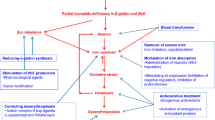Abstract
High oxidative stress status is known to be one of the most important factors determining cell injury in thalassemic patients and causing other serious medical complications, including a continuous proinflammatory status. The quantification of protein carbonyl groups in peripheral blood is widely used to measure the extent of oxidative modification. Thus, we measured serum concentrations of protein carbonyl groups in 30 patients affected by thalassemia major and in 15 healthy subjects. Strongly higher levels of protein carbonyl groups were measured in the blood from thalassemic patients than in that from healthy controls. Our findings evidence that thalassemic patients suffer from protein oxidative stress; the possibility of a role for carbonyl stress in the progression and severity of the disease needs further investigation.
Similar content being viewed by others
References
Dalle-Donne I, Giustarini D, Colombo R, Rossi R, Milzani A (2003) Protein carbonylation in human diseases. Trends Mol Med 9:169–176
Filosa A, Valgimigli L, Pedulli GF, Sapone A, Maggio A, Renda D, Scozzone C, malizia R, Pitrolo L, Lo Pinto C, Borsellino Z, Cuccia L, Capra M, Canestro D, Broccoli M, Soleti A, Paolini M (2005) Quantitative evaluation of oxidative stress status on peripheral blood in beta-thalassaemic patients by means of electron paramagnetic resonance spectroscopy. Br J Haematol 131:135–140
Gangemi S, Merendino RA, Meo A, Minciullo PL, Briglia S, Merlino MV, Rigoli L, Tomasello c, Sampietro CD (2003) Serum levels of interleukin-18 in splenectomized and nonsplenectomized thalassemic patients: preliminary considerations. Acta Haematol 110:45–47
Haddad JJ (2002) Antioxidant and prooxidant mechanisms in the regulation of redox(y)-sensitive transcription factors. Cell Signal 14:879–897
Kassab-Chekir A, Laradi S, Ferchichi S, Hai Khelil A, Feki M, Amri F, Selmi H, bejaoui M, Miled A (2003) Oxidant, antioxidant status and metabolic data in patients with beta-thalassemia. Clin Chim Acta 338:79–86
Kormoczi GF, Saemann MD, Buchta C, Peck-Radosavljevic M, Mayr WR, Schwartz DWM, Dunkler D, Spitzauer S, Panzer S (2006) Influence of clinical factors on the haemolysis marker haptoglobin. Eur J Clin Investig 36:202–209
Kumar S, Bandyopadhyay U (2005) Free heme toxicity and its detoxification systems in human. Toxicol Lett 157:175–188
Morabito F, Cristiani M, Saija A, Stelitano C, Callea V, Tomaino A, Minciullo PL, Gangemi S (2004) Lipid peroxidation and protein oxidation in patients affected by Hodgkin’s lymphoma. Mediators Inflamm 13:381–383
Schrier SL, Centis F, Verneris M, Ma L, Angelucci E (2003) The role of oxidant injury in the pathophysiology of human thalassemias. Redox Rep 8:241–245
Author information
Authors and Affiliations
Corresponding author
Rights and permissions
About this article
Cite this article
Trombetta, D., Gangemi, S., Saija, A. et al. Increased protein carbonyl groups in the serum of patients affected by thalassemia major. Ann Hematol 85, 520–522 (2006). https://doi.org/10.1007/s00277-006-0115-3
Received:
Accepted:
Published:
Issue Date:
DOI: https://doi.org/10.1007/s00277-006-0115-3



